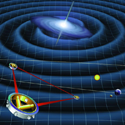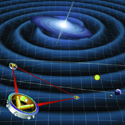Sensitivity training for LISA
Gravitational waves, often described as ripples in spacetime, are emitted when two massive objects, like black holes or neutron stars, collide. Unfortunately, the waves are so weak by the time they arrive to earth that, so far, existing interferometers have failed to detect them.
Another approach is the planned Laser Interferometer Space Antenna (LISA), a joint mission between the European Space Agency and NASA, which will serve as a space-based gravitational wave detector. Although nominally not as sensitive as land-based detectors, LISA would be free of seismic noise and operates in a lower frequency window, where the remaining noise sources should be relatively weak compared to the gravity wave signal.
Now, writing in Physical Review Letters, Glenn de Vine and colleagues at the Jet Propulsion Laboratory (JPL) in Pasadena, US, present the first experimental verification of the technique underlying LISA’s design, called “time-delay interferometry.”
LISA will consist of three spacecraft forming a triangle, five million kilometers along each side, and linked by lasers. If a gravitational wave passes through the orbiting “constellation,” the lasers will perceive the minute shifts in the distance between the spacecraft.
This laser interferometry setup is designed to detect deflections as small as picometers, but the clear culprit will be noise. De Vine and colleagues therefore designed a laboratory scale version of LISA and showed they were able to suppress two potentially damaging noise sources: phase fluctuations in the clocks that synchronize the measurements and frequency fluctuations in the lasers.
The team was able to suppress both noise sources by several orders of magnitude—an encouraging achievement that bodes well for the underlying optical design of LISA and its future as a gravitational wave detector. – Jessica Thomas





